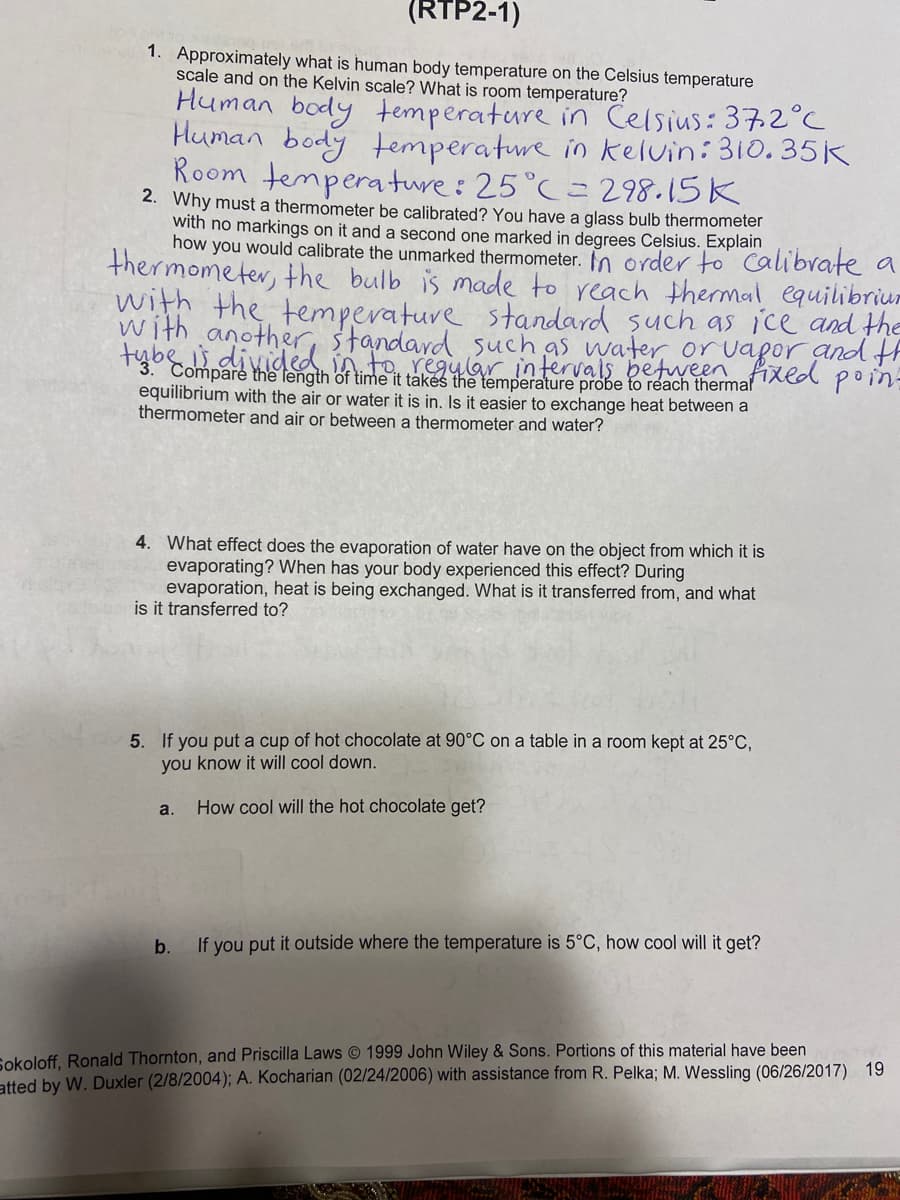4. What effect does the evaporation of water have on the object from which it is evaporating? When has your body experienced this effect? During evaporation, heat is being exchanged. What is it transferred from, and what is it transferred to?
4. What effect does the evaporation of water have on the object from which it is evaporating? When has your body experienced this effect? During evaporation, heat is being exchanged. What is it transferred from, and what is it transferred to?
Chemistry
10th Edition
ISBN:9781305957404
Author:Steven S. Zumdahl, Susan A. Zumdahl, Donald J. DeCoste
Publisher:Steven S. Zumdahl, Susan A. Zumdahl, Donald J. DeCoste
Chapter1: Chemical Foundations
Section: Chapter Questions
Problem 1RQ: Define and explain the differences between the following terms. a. law and theory b. theory and...
Related questions
Question
100%
Question 4

Transcribed Image Text:(RTP2-1)
1. Approximately what is human body temperature on the Celsius temperature
scale and on the Kelvin scale? What is room temperature?
Human body temperature in Celsius: 372°C
Human body temperature in kelvin:310.35K
Room temperature: 25°C = 298.15K
2. Why must a thermometer be calibrated? You have a glass bulb thermometer
with no markings on it and a second one marked in degrees Celsius. Explain
how you would calibrate the unmarked thermometer. n order to calibrate a
thermometer, the bulb is made to reach thermal equilibriur
with the temperature standard such as ice and the
with another, standard such as water or vagor and t
tybe divided in to regylar intervals betweenafixed poin
Compare the length of time it tåkes the temperature probe tfo reach thermaľ
equilibrium with the air or water it is in. Is it easier to exchange heat between a
thermometer and air or between a thermometer and water?
4. What effect does the evaporation of water have on the object from which it is
evaporating? When has your body experienced this effect? During
evaporation, heat is being exchanged. What is it transferred from, and what
is it transferred to?
5. If you put a cup of hot chocolate at 90°C on a table in a room kept at 25°C,
you know it will cool down.
a.
How cool will the hot chocolate get?
b.
If you put it outside where the temperature is 5°C, how cool will it get?
Sokoloff. Ronald Thornton, and Priscilla Laws © 1999 John Wiley & Sons. Portions of this material have been
atted by W. Duxler (2/8/2004); A. Kocharian (02/24/2006) with assistance from R. Pelka; M. Wessling (06/26/2017) 19
Expert Solution
This question has been solved!
Explore an expertly crafted, step-by-step solution for a thorough understanding of key concepts.
This is a popular solution!
Trending now
This is a popular solution!
Step by step
Solved in 2 steps

Knowledge Booster
Learn more about
Need a deep-dive on the concept behind this application? Look no further. Learn more about this topic, chemistry and related others by exploring similar questions and additional content below.Recommended textbooks for you

Chemistry
Chemistry
ISBN:
9781305957404
Author:
Steven S. Zumdahl, Susan A. Zumdahl, Donald J. DeCoste
Publisher:
Cengage Learning

Chemistry
Chemistry
ISBN:
9781259911156
Author:
Raymond Chang Dr., Jason Overby Professor
Publisher:
McGraw-Hill Education

Principles of Instrumental Analysis
Chemistry
ISBN:
9781305577213
Author:
Douglas A. Skoog, F. James Holler, Stanley R. Crouch
Publisher:
Cengage Learning

Chemistry
Chemistry
ISBN:
9781305957404
Author:
Steven S. Zumdahl, Susan A. Zumdahl, Donald J. DeCoste
Publisher:
Cengage Learning

Chemistry
Chemistry
ISBN:
9781259911156
Author:
Raymond Chang Dr., Jason Overby Professor
Publisher:
McGraw-Hill Education

Principles of Instrumental Analysis
Chemistry
ISBN:
9781305577213
Author:
Douglas A. Skoog, F. James Holler, Stanley R. Crouch
Publisher:
Cengage Learning

Organic Chemistry
Chemistry
ISBN:
9780078021558
Author:
Janice Gorzynski Smith Dr.
Publisher:
McGraw-Hill Education

Chemistry: Principles and Reactions
Chemistry
ISBN:
9781305079373
Author:
William L. Masterton, Cecile N. Hurley
Publisher:
Cengage Learning

Elementary Principles of Chemical Processes, Bind…
Chemistry
ISBN:
9781118431221
Author:
Richard M. Felder, Ronald W. Rousseau, Lisa G. Bullard
Publisher:
WILEY